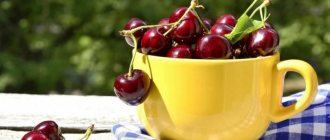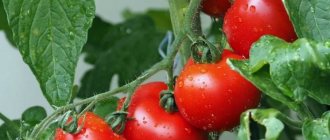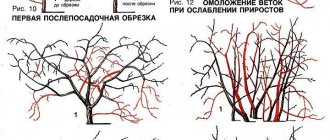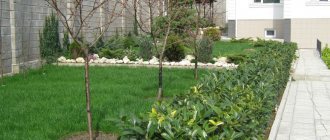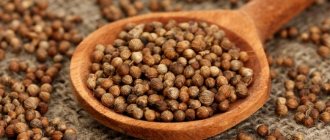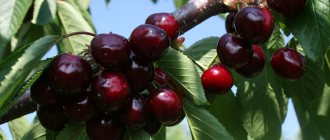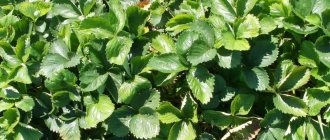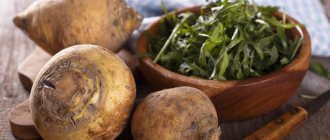What do you spray cherries with?
Unfortunately, cherries in orchards often suffer from diseases and pests, as a result of which the trees cannot prepare for winter and freeze and die in cold weather. To avoid this, you need to help the plants in a timely manner.
You will need
- — sprayer;
- — protective clothing;
- - respirator.
Instructions
- To avoid crop loss, you need to pay attention to the prevention and treatment of garden trees, regularly inspect them and immediately take measures for treatment. In addition, you need to be able to distinguish between the types of pests and diseases that affect the orchard.
- Coccomycosis is a parasitic fungus that appears as brownish-red dots on the leaves, which subsequently turn into brown spots. A white-pinkish coating is noticeable on the underside of the leaves. These are fungal spores. When damaged, leaves fall from the branches and the tree cannot fully prepare for winter. The infection also affects cherry fruits. In this case, they become deformed and lose their taste.
- To get rid of the pathogen, you need to remove and burn fallen leaves, and dig up the soil under the trees twice a season. In addition, it is necessary to spray the plants three times with antifungal drugs: after the leaves bloom, spray with a 3% Bordeaux mixture, and immediately after the flowers fall off, the trees must be treated with Trypsin-M, Skor in accordance with the instructions or copper oxychloride (0. 4%). After harvesting, trees and bushes are sprayed again in the same way as spring treatment.
- Moniliosis is another fungal disease that causes leaf burns. In this case, the tree bark is also damaged: gray growths form on it, cracks form on the damaged branches, and the plant slowly dies. Cherry fruits also suffer; they rot right on the branches. Bordeaux mixture, iron sulfate or Nitrafen are also used for treatment. Cherry trees and bushes should be sprayed after flowering. It is important to keep the area around the trees clean.
- Anthracnose is also a fairly common disease of cherries that affects its fruits. In this case, spots form on the cherry, which subsequently develop a pinkish coating, then the fruits dry right on the stalks. To combat this disease, it is necessary to spray with the drug “Poliram” twice during the summer, and destroy the diseased fruits.
- Pests also cause no less trouble: cherry aphids, weevils, sawflies, shoot moths, aphids - everyone tries to have time to feast on young buds, ovaries and flowers. If you don't take care of your garden, these inconspicuous insects can destroy your entire harvest. Fortunately, there are quite a few chemicals that destroy these pests: “Iskra”, “Commander”, “Korado” will leave no chance for insects.
- KakProsto.ru
Processing strawberries in early spring
Processing strawberries in the spring is an important event that cannot be ignored. And there is little time for processing - you need to do it before flowering begins. And the very first thing you need to do is remove old leaves and debris from the strawberry bed, clear the rosettes of dry leaves, and remove weeds.
The soil also needs to be protected from pests and diseases. To do this, the soil between the rows is watered from a watering can with water heated to 95°C. This measure will rid strawberries of pest larvae that remain in the ground for the winter. In order for a hot shower to be detrimental to soil monsters, it is recommended to add potassium permanganate to the water (until it turns slightly pink).
The most important enemies of strawberries are powdery mildew, gray rot, white rot, black rot, and verticillium wilt. To avoid all this, you need to treat the bushes with antifungal agents that contain copper - these are Horus, Topaz, 1% Bordeaux mixture, etc.
If in the previous season your garden was subject to an active invasion of pests, then you need to strengthen safety measures and control them.
Spraying trees against pests - when, with what and in what order
One of the main conditions for caring for fruit trees is seasonal processing. This procedure is carried out by every gardener who wants to grow a beautiful garden with a high yield. Spraying trees in the spring with the necessary preparations will protect the garden from invasion of pests and pathogens.
The effectiveness of spring spraying
The main objective of this treatment is to protect against the appearance of butterflies, aphids, caterpillars and various beetles, as well as to minimize the likelihood of infectious, viral and fungal diseases.
- For example, aphids cause great damage to fruit trees such as apple, pear, plum, apricot and cherry plum. This insect infects the bark of a tree, forming nodules on its surface, which over time crack, turning into sores. Aphids attack tree leaves, which first curl and then dry out. Damaged specimens eventually stop growing and dry out.
- The main enemy of plums, cherries and cherries is the cockchafer, or rather its larvae, which live in the ground for three years. This insect can destroy entire plantations of young trees, affecting their root system. The adult beetles fly in May, and they also destroy young leaves and fruit ovaries. Spraying trees in the spring makes their leaves unattractive to beetles.
- Flower beetles are ubiquitous. With the warmth, weevils crawl out of the soil where they hibernated and rush to the opening flowers, which eat away the stamens and pistils. Measures to combat them are to dig up the tree trunk circles in late autumn (or cover them with a thick layer of straw, hay, sawdust, through which the beetles cannot get out).
- Sawflies and moths. These harmful insects can make the entire crop of apples, pears, plums, peaches, and nectarines simply inedible. Control measures are only spraying.
Chemical treatment of the above-ground parts of fruit trees allows you to preserve not only the foliage, but also the ripe fruits, which means you can get a tasty and healthy harvest.
Irrigation of the orchard with chemicals should be carried out in a timely manner. Untimely and incorrect treatment of plants will not give any effect.
When and how many times to spray?
Spraying of fruit trees is carried out repeatedly, starting in early spring and ending in late autumn.
Gardeners, taking into account their many years of experience, have drawn up a special schedule for spraying the orchard. It describes in detail what and when to spray trees throughout the season. The first spraying of fruit plantings against pests is carried out in early spring. Many inexperienced gardeners wonder under what weather conditions this procedure can be carried out. So, experts recommend doing the first pollination immediately after the snow melts, at a temperature of about 5-6 degrees Celsius.
Processing of fruit trees is often carried out in the second half of March. Just at this time, the plants begin the process of bud growth. During spraying, as well as during the process of pruning trees, the gardener should pay special attention to cracks that may contain harmful insects. Before treating trees, they need to be prepared for this. The trees are thoroughly cleaned with a brush, then a freshly prepared solution is applied. The solution is used on the day it is prepared, otherwise it will become useless. It will not remove pests, but the trees may be seriously burned.
Treatment of the garden in March is aimed at combating insects that infect trees by getting out of the soil.
The next spraying is carried out in April. The purpose of this spray is to protect flower buds on trees from various fungal diseases and the stag beetle.
May processing is carried out in order to prevent the appearance of harmful insects and diseases. This procedure is carried out after the trees bloom.
The treatment of the garden does not end there; with the onset of autumn, additional spraying follows. This is a kind of preparation of fruit trees for winter. As soon as the trees lose their leaves, in October-November, you can begin to process them. It is recommended to use chemicals. If spraying is carried out without their use, then the first autumn treatment can be carried out immediately after harvesting - in September.
How to prepare trees for spraying?
Trees over 6 years old are cleaned of old bark and lichens with a brush.
Growths and any accumulations on the trunk of trees do not in any way affect their general condition. But it is worth noting that it is in these places that pathogens most often like to accumulate. Immediately after cleaning, spraying is carried out. The final processing of fruit plantings, as well as shrubs, is carried out after harvesting and falling leaves. The area is completely cleared of weeds and leaves. The latest spraying of the garden is carried out after the first frost.
What and from what diseases should I spray trees in the spring?
There are several effective preparations that gardeners use when treating fruit trees and shrubs. Today there are many substances for spring and autumn processing of orchards. The most popular products used by many gardeners over the years:
- Inkstone.
- Copper sulfate.
- Urea or urea.
- Diesel fuel.
- Drug 30B.
It is impossible to give preference to any one of the above remedies, since each of them is aimed at eliminating a specific disease or pest. One drug can be used only in spring, the other in autumn. Experienced gardeners recommend stopping spraying fruit trees and shrubs with chemicals 3-4 weeks before harvest.
inkstone
The garden is treated with iron sulfate twice during the entire season. The first spraying is carried out during the period of foliage formation, and the second - when the trees are preparing for winter. This drug has a double effect. It enriches shrubs and trees with iron, and is also an effective protection against various pests and diseases. Iron deficiency in fruit trees manifests itself in a unique way – low yield and underdeveloped fruits. Spraying of fruit plantings with iron-based vitriol is carried out not only in spring, but also in autumn, for preventive purposes, and also to destroy lichen, moss, cytosporosis, black cancer and septosporosis.
Copper sulfate
Treatment of the garden with copper sulfate is carried out according to the same scheme as the previous preparation - twice a season.
The first treatment is carried out in early spring, even before the appearance of young buds. This substance must be handled with care, since copper sulfate, even the weakest concentration, can burn young foliage on trees. This is an excellent disinfectant that heals wounds on the trunk of trees and shrubs. This fungicide is sprayed on trees such as pear, plum and apple trees, both in autumn and spring. Copper sulfate protects orchards from moniliosis, scab, cluster blight and curl. For one young tree, up to 6 years old, apply 2 liters of freshly prepared solution. For adult specimens, use 10 liters of liquid. The garden is processed in the morning or evening, when there is no wind, at a temperature of 10 to 25 degrees. On hot days, it is recommended to refrain from using this drug, as it is quite aggressive and can harm both animals and people. The solution is prepared in a place remote from water bodies.
Urea (urea)
Carbamide (urea) is considered an equally effective drug against pests.
The first care of orchards in early spring begins with spraying them with this particular preparation. This procedure is carried out immediately after flowering. The second spraying with this substance is carried out before wintering. Urea is intended to save the crop from the invasion of various pests. A properly made solution allows you to achieve the desired effect. During the first spraying, high-concentration urea is used with the addition of a small dose of copper sulfate. This remedy is effective not only against all kinds of pests, but also allows you to slow down the growing season of some fruit trees by 2-3 weeks. This helps preserve the color on the trees during the last frost.
7 days after flowering, fruit plantings are sprayed with a weaker solution of urea: 50 g of the substance is diluted with a bucket of water. This will protect the trees from leaf rollers, aphids, caterpillars, copperheads and flower beetles.
The second treatment is carried out in the fall, when half of the trees are left without leaves. In this case, a solution of increased concentration is used. Spraying is also carried out after the leaves have completely fallen off. In this case, the treatment is carried out with a urea solution with an 8-10% concentration. Not only trees, but also the soil around them are subject to this treatment. This substance has a dual effect - it disinfects plantings and also nourishes the soil. It is very important to choose the right concentration so as not to harm the trees or reduce their resistance to cold.
Diesel fuel
Just like other drugs, it is used twice - in autumn and spring.
This petroleum product should be used with extreme caution as it can cause burns to trees and shrubs, resulting in their death. Therefore, spraying with diesel fuel is carried out strictly before the formation of buds and leaves on the trees in the spring. The second spraying is carried out only after the trees have completely shed their leaves. This substance is strictly prohibited from being used in its pure form. It is diluted with water or other liquid, thereby reducing the concentration and destructive effect. A diluted solution of diesel fuel is very effective in fighting rot.
Preparation 30B
It is used in early spring and late autumn.
The finished solution consists of 200 g of the substance, diluted with 1 bucket of water. Treatment with this substance destroys many pests that have persisted on the trunk and branches since the fall. This can be false scale insects, aphids, whiteflies, scale insects, leaf rollers and moths, etc. Preparation 30B is often used in the fight against insects in the summer. This substance is considered harmless. When applied, it forms a thin film on the tree cover, which prevents the supply of oxygen and moisture to pests at the stage of eggs and larvae. Such conditions ultimately lead to the death of insects. Despite the harmlessness of this substance, experienced gardeners use it no more than once every three years.
What to spray trees with?
Today, two types of devices for spraying orchards are produced - manual or mechanical.
This is a necessary thing for the correct and effective procedure. It improves spray quality and protects the gardener from contact with the chemical. Each device is equipped with a pump. To work with drugs in powder form, there are devices with air supply. Mechanical devices are characterized by convenience and high cost. The pumping principle for manual and mechanical devices is also different. Each model has its pros and cons. Therefore, here you should proceed from the needs and capabilities when purchasing this item.
LetovSadu.ru
Spraying the garden before flowering is carried out twice. The first time - “along the green cone”, that is, when the flowers have not yet begun to bloom and are more like cones (unopened buds). Most often, the procedure serves as a preventive measure against scab, spotting and powdery mildew.
Scab is a fungal disease that affects the leaves, shoots and fruits of trees. A diseased plant has a rather lethargic appearance, develops poorly and becomes covered with spots (rot). Most often it affects cherries, apples and pears. Powdery mildew is also a fungal disease, but it mostly affects apple trees and occasionally spreads to pear trees. Spot is a stone fruit disease that affects leaves and fruits.
Repeated spraying of the garden before flowering is an event aimed largely at pest control. It is carried out in the “bud separation” phase. It is at this time that the larvae of most insects hatch. Killing them at this time is quite simple with the help of ordinary karbofos (urea). No less effective are the drugs Fufan and Fury (Taran).
It is effective to repeat the procedure while the trees are abundantly covered with flowers - this is the so-called second spraying of the garden during flowering . Duration: until 75% of all petals fall. For the procedure, active substances are selected that fight both pests and diseases. For example, ordinary urea is suitable for inexpensive products.
Our professional gardeners with many years of experience will be able to help you select preparations for early spring garden spraying and carry out sanitary procedures. We will take good care of your landing!
Means for processing cherries
To combat pests and diseases of cherries, they use products whose use is less dangerous for humans and trees. Preference is given to safe drugs and various folk remedies. Chemical poisons are resorted to in exceptional cases.
Chemicals
In spring, it is necessary to use two groups of preparations for spraying garden trees - fungicides and insecticides. During this period, treatments are precautionary in nature, so the tree is protected from all possible threats.
Popular drugs:
- Vitriol. There are two varieties - copper and iron. An excellent antifungal agent. Prevents the development of scab, the appearance of moss and lichen, protects against cherry aphids.
For spraying, use 1-3% and 5% solutions of copper and iron sulfate, respectively. - Urea. An antifungal drug with a pest protection effect. Use a 5% solution.
- Bordeaux mixture. A universal remedy - helps protect the tree from aphids and fungal infections.
- Copper oxychloride. Today this product is sold in the form of various fungicides - “Skor”, “Horus” and others. Effective in the fight against all fungal diseases.
- Karbofos. A universal insecticide used against various pests. The recommended dosage is 80 g per bucket of water.
- Fufanon. A universal product that destroys most pests of cherries. Dosage – 10 ml per 10 liters of water.
The use of the chemical drug "Karbofos" requires not only caution, but also serious reasons, since it destroys pests and beneficial insects that pollinate trees.
Folk remedies
Gardeners love traditional processing methods because they are cheap and safe. These products do not require special costs, their use is not associated with danger to humans and beneficial insects.
The downside of folk remedies is their relatively low effectiveness. They are usually used for prevention - before massive damage to the tree begins.
Popular means:
- Tobacco infusion. Pour half a kilogram of dry tobacco leaves into a bucket of water and leave to infuse. After two days, boil the infusion and leave for 24 hours. Then mix a liter of infusion with a bucket of water and add 40 g of grated laundry soap. Use the resulting solution to treat the tree crown and the soil around the tree trunk. Instead of tobacco leaves, you can use dry tobacco dust or wood ash.
- Pepper infusion. Pour 100 g of dry hot pepper pods with a liter of boiling water. Cook for 2 hours, and then leave for another 2 hours. After straining the broth, add water to make 10 liters and spray the crown with the product.
- Other infusions. A variety of herbs and vegetables can be used for spraying. For example, they can be prepared from: chopped onion or garlic - 600 g per 10 l;
- wormwood – 400 g per 10 l;
- chamomile flowers – 150 g per 10 l.
In spring, sow flowers and plants with a strong aroma under the cherries - velvets, nasturtium, fennel, dill. In the summer they will scare away “uninvited guests” from the trees.
Spring (second half)
As soon as the last petals fall on the plants, it’s time to start the next activity - spraying the garden after flowering. The drug is selected depending on the type of tree:
- Pear and apple trees - scab and other types of spotted diseases actively appear on these plants after flowering. For them, choose one of the following drugs: Vectra, Impact, Rubigan, Strobe or Speed. In this case, the procedure is repeated after 2 weeks, replacing the selected fungicide with another from the list.
- Apricot - Hole spot and monilial burn may appear here. The garden is sprayed with copper sulfate or Bordeaux mixture. It is effective to add insecticides against leaf rollers and moths.
- Peach - the main danger comes from leaf curl, clasterosporia blight and codling moth caterpillars. Copper-based fungicides are suitable, as well as insecticides: decis, stefesin.
- Plum - most of the damage can be caused by codling moth caterpillars, aphids and mites, as well as the diseases moniliosis and polystigmosis. Plantings are treated with one of the following poisons: Danadim, Zolon, Fufanon with the addition of a copper-based fungicide.
- Cherries and sweet cherries - in such orchards there is damage from clasterosporiasis and coccomycosis, as well as pests: cherry flies and aphids. Proper garden spraying in the spring consists of treating stone fruits with one of the following active substances: topsin, copper oxychloride, with the addition of poisons against pests.
To protect the garden from tick invasion and prevent fungal diseases, trees are often treated with DDT powder diluted in water or the garden is sprayed with urea. By the way, the use of urea has another important function - saturating vegetation with nitrogen. That is why urea is the most popular remedy.
Moniliosis, coccomycosis and verticillium wilt of cherries
The most common fungal diseases of cherries are moniliosis, coccomycosis and verticillium . We recommend growing varieties that are resistant to these diseases. This is the best way to fight)))
Cherry varieties resistant to moniliosis and bacterial stone fruit cancer:
- Silvia
- Homestead
- Valery Chkalov
- Tenderness
- Gastinets
- Kitaevskaya Black
- Van-Compact
Preparations for spraying cherries against moniliosis, coccomycosis and other diseases:
Summer
In the summer, the garden is most often sprayed with urea. As mentioned above, this fungicide perfectly saturates trees with nitrogen and also kills many types of pests. The procedure is carried out several times during the hot season; urea is used as a nitrogen-containing fertilizer.
Basically, in the summer, special preparations are used to spray the garden against certain types of pests. More precisely, in order to combat insects that have managed to get into the garden and occupy the trees. You can purchase such insecticides at any specialized store.
They try to treat young plants with folk remedies, since they are absolutely safe for young plants (“strong” fungicides and insecticides can leave burns on the seedlings). For example, against aphids, the garden is sprayed with tobacco or another strong-smelling tincture. These insects cannot tolerate strong odors.
Our professional gardeners will help you select a product and treat your garden with it. We have protected hundreds of gardens and provided them with acceptable conditions for growth and development!
The most common diseases of fruit trees
The causative agents of diseases of garden plants are spores of various parasites, which are spread by insects or by air. Each disease has certain symptoms - changes in foliage color, the appearance of various types of defects.
Scab
The greatest damage is caused to the health of apple and pear trees. Foliage, fruits, and young shoots of pear trees are infected. With high humidity during rainy seasons, scab affects the ovaries and flowers of plants. Symptoms of the disease include the following:
- premature yellowing, drying out, falling leaves;
- the appearance of various deformations, cracking, rot in fruits;
- the tree bark begins to peel and crack;
- the tops of the shoots dry out.
Scab most often affects apple and pear trees. Foliage, fruits, and shoots suffer from it.
Important! The results of the disease are a decrease in the number of fruits, their quality, slow growth or stopping the development of shoots, weak resistance of trees to cold during winter, autumn or spring frosts.
Powdery mildew
Apple and peach crops are most often infected, sometimes quince, plum, and apricots. Manifestations of the disease can mainly be seen on foliage and shoots. In the final stages, flowers and fruits are affected.
Powdery mildew provokes a slowdown in the development of inflorescences, curling of leaves, and rotting of fruits
The most typical symptoms include the following:
- white coating with a powdery consistency;
- over time, the plaque on young buds may disappear, but instead a noticeable mesh remains on the surface;
- curling, hardening and premature falling of leaves;
- curvature, stopping the growth of shoots with their subsequent death;
- slow development of inflorescences;
- deformation of flower petals, the appearance of a yellow-green tint;
- infected fruits do not have time to ripen, dry out and fall prematurely;
- the fruits of affected garden trees grow small and often crack and rot.
Important! The disease leads to a significant reduction in yield. Plants become weak and often die during frosts.
Plants become weak and often die due to powdery mildew.
Moniliosis
The pathogen is transferred to the surface of plant tissue by insects, birds, and scab spores. The disease is typical for crops whose fruits contain seeds and seeds. The form of painful manifestations is monilial burns or fruit rot. As a result of their influence, inflorescences and fruit branches die off. Concentric circles of mycelium appear on the surface of the fruit.
Important! Most of the crop rots directly in the garden or during storage.
Moniliosis is a fungal disease that often affects apple, quince, and pear trees.
Juniper rust
The causative agents of the disease infect juniper thickets, but can use unstable varieties and weak pear trees growing nearby as a “transit point”. The disease manifests itself in disturbances in the processes of photosynthesis. Organ tissues and foliage of an infected plant quickly dry out and fall off. Tree productivity, fruit quality, and resistance to cold drop sharply. To avoid infection, it is necessary to get rid of juniper thickets near pear trees.
Juniper rust
Clusterosporiasis
Almost all plant organs of apricot and peach crops often suffer from the disease, but the pathogens can infect any trees with seeds in the fruits. Affected plant ovaries may fall off, and ripened fruits quickly deteriorate. The trees become weaker and their productivity drops sharply.
Important! At advanced stages of the disease, the shoots and branches dry out, and eventually the plant dies.
Apricot and peach trees suffer from clasterosporia blight more often than others.
Coccomycosis
The main threat of the disease is to the foliage, stalks, berries of cherries and cherries; less often, unstable varieties of cherry plums, plums, and apricots are infected. In the last stages of the disease, abundant premature leaf loss begins. The structure of the fruit changes - they become soft and watery, and their taste deteriorates. The trees become weak and may not survive the winter and die.
Coccomycosis causes weakness of trees, their death, and deterioration in the quality of fruits
Autumn
In autumn, fruit bearings are sprayed twice. For the first time at the beginning of autumn, urea is the last replenishment of the vegetation with nitrogen. It is not recommended to use nitrogen-containing compounds anymore.
After leaf fall, plants are treated with drugs aimed at combating putrefactive diseases. You can purchase special chemicals for spraying your garden in the fall or prepare an excellent mixture at home:
- dissolve 300 grams of copper (for apple trees - iron) sulfate in 3 liters of water;
- Mix 400 grams of fluff lime with 10 liters of water;
- pour diluted vitriol in a thin stream into the lime mortar, stirring constantly;
- strain the resulting mixture through gauze folded several times.
Regardless of what product you use (buy specialized poisons for spraying the garden or prepare the mixture yourself), the procedure should be carried out in dry weather around the beginning of November.
By the way, the solution described above has a soft blue color, so don’t be surprised. Yes, your plants will be slightly painted in a heavenly color, but they will remain absolutely healthy, and the “paint” will wash off over time.
Spraying schedule for apple and pear trees after flowering
When choosing drugs and procedures to protect apple and pear trees, one must focus on the fight against codling moths and scab. Measures to destroy these pests and parasite spores can stop other insects and pathogens.
For high-quality processing it is necessary to carry out the following spraying:
- 1st – immediately after the trees bloom;
- 2nd – under conditions of high humidity, frequent rains 8-10 days after the first spraying;
- 3rd – with a total air temperature of 230° or after catching five males of the first generation of codling moths using pheromone traps;
- 4th – at the end of 10 days after the previous spraying;
It is recommended to carry out several sprayings of trees to prevent and destroy parasites and pathogens
- 5th – with a total air temperature of 650° or after catching from 3 to 5 males of the second generation of codling moths with a pheromone trap;
- 6th – only autumn and winter varieties are processed 10-12 days after preliminary spraying;
- 7th – only winter varieties are sprayed 10-12 days after the previous procedure;
- 8th – no later than 20 days before harvest.
| Plant | Drugs |
| Apple trees | When treating apple trees, it is recommended to use solutions from the following insecticidal preparations - “Aktar”, “Altex”, “Bombardir”, “Biotlin”, “Borey”, “Decis”, “Confidor”, “Calypso”, “Nuprid”, “Taurus” , "Karate Zeon". Fungicides – “Bordeaux”, “Coronet”, “Skor”, “Flint”. |
| Pears | For pears, insecticidal solutions from Aktara, Biotlin, Envidor, and Tanrek are most effective. Among the fungicides, mixtures using “Switch”, “Skor”, “Horus”, “Tiovita Jet” are suitable. |
It is important to follow the instructions on the packaging of the product so as not to harm either the tree or yourself.
Spraying the garden
The technological process is quite simple, but it requires patience, time and the availability of certain tools. First, let's determine what is needed to carry out the procedure. Garden spraying equipment (tools and consumables):
- a special compressor for processing trees or a piston-type pump;
- protection: respiratory mask (can be replaced with a multi-layer gauze bandage), rubber gloves (the use of fabric gloves is highly undesirable), goggles (mandatory protection against contact of potent substances with the eyes);
- substances for treating trees are selected depending on the time of the procedure (for example, spraying a garden in April is carried out using Bordeaux mixture or urea).
The technology for processing trees is quite simple:
- Using a pump or compressor, spray the fungicide (insecticide) evenly over the plant. Make sure that the substance falls in an even dew. It is important to treat all parts of the tree (the leaves are sprayed on both sides).
- After finishing work, be sure to wash the device without removing the protective elements.
- Next, you should thoroughly wash your hands and face with plain (or antibacterial) soap, and rinse your mouth.
As promised, we provide a garden spraying calendar. All mandatory procedures and approximate times for events are listed here:
Now you are theoretically prepared for work. It remains to wish you success in all your practical endeavors!
Let us remind you that our professional gardeners will help you treat your garden. We will take care of your site as if it were our own for a small monetary reward!
derevoved.com
The cherry fly (Rhagoletis cerasi) from the variegated fly family lives everywhere. The greatest harm from the parasite is observed in the Republic of Dagestan and in the south of Ukraine, where damage to fruits can exceed 50%.
The body length of an adult fly is 29–53 mm. The forehead and the front half of the insect's head are golden-yellow, the body is glossy, dark brown or almost black; the eyes of the fly are green, the thighs are black. The wings are transparent with wide transverse stripes of a dark brown color and yellowish at the base. The shield, tarsi and tibiae have yellowish-orange tints. There are two wide longitudinal stripes on the sides of the chest. The female differs from the male in its larger size and large abdomen, pointed downward.
The egg has an elongated oval shape and is pointed on one side. The egg shell is smooth, yellowish-white. The egg reaches 0.75 mm in length and 0.22 mm in width. Closer to the top, the egg has a faint pattern of thin lines forming small hexagons.
The cherry fly larva has an elongated white body narrowed towards the head, which consists of 13 segments. The integument of the larvae is thin, with a well-developed mouthparts visible through them. During the entire period of existence, the larva goes through 3 stages of development:
- Body length – 0.65–1.74 mm. The posterior spiracles are very poorly developed and have two round openings. Thoracic spiracles are absent.
- Body length – 1.8–3.65 mm. The posterior spiracles become larger, acquire a wide oval shape and three spiracular slits. Thoracic spiracles appear.
- The body length reaches 6–7 mm. The posterior and anterior spiracles are well developed. The posterior spiracular slits are elongated and straightened.
From the skin of the third stage larva, a false cocoon is formed, in which the fly larva becomes a pupa. During this period, organs and body parts of an adult insect are formed. The length of the false cocoon (puparia) is 2.5–4.5 mm, the color is yellowish.
What diseases are typical for cherries?
Fungal diseases threaten cherries and cherries equally. The cherry tree is pruned moderately, so its crown is often thickened, which creates the preconditions for the emergence of an outbreak of spores of some fungus. Years with high rainfall and prolonged cool weather are especially favorable for the development of diseases.
After flowering, the tops of the cherry branches wither and turn brown, standing as if burned. Spores enter the wood during flowering through the flowers. Fruits also die throughout the tree - spores penetrate through damage caused by insects. The berries rot and become covered with gray mycelium.
Insect lifestyle and reproduction
For wintering, the pupae go 3–5 cm deep into the soil. In the spring, when the surface of the earth 5 cm deep warms up to 10 degrees, young flies emerge from their hiding places.
Males are born first, and females appear later - after 4-5 days.
The emergence of young flies in the southern regions continues from mid-May to mid-July. The reddish-gray and sluggish insect has an underdeveloped reproductive function. In the first few days, the female needs increased nutrition: juices secreted from cracks in leaves, trunks and fruits, sweet secretions of aphids and leaf flea beetles. After 2–3 days, having grown stronger, the insects begin mating.
Mating occurs in warm sunny weather at a temperature not lower than 18 degrees. After 7–10 days, the female lays eggs. To do this, she looks for suitable places, carefully studying each fruit. Both ripe and still green berries are suitable. Having positioned the ovipositor perpendicular to the surface of the fruit, the female pierces it and lays eggs in the nutritious pulp. The whole process lasts no more than 4 minutes. The lifespan of a female is about 1 month. During this time, she lays up to 150 eggs - 1 egg in each fruit.
The development of the larva in the egg occurs within 7–10 days. After this, the larva continues to live in the berry and feed on its pulp. This stage lasts 15–25 days. The strengthened larva falls to the ground and, burrowing into the surface layer of soil, turns into a pupa. The insect remains in this state until the spring of next year. 14% of pupae end up in unfavorable conditions, which delays the further development of the pest for several years.
If you want to get rid of pests effectively, but without using chemicals, then attract insect riders to your gardens.
Mealybugs are incredibly difficult to control. But we know how to destroy these pests. You will find all the remedies in this article.
"Trichodermin" is a drug of biological origin, which is intended to combat plant diseases. Read the description of this tool at https://stopvreditel.ru/rastenij/borba/trixodermin.html link.
Prevention
Naturally, plants suffer from more than one pest, and therefore it is necessary to devote time to prevention from the main categories of threats. This business begins in the spring - in April, just at the time when the sap begins to move through the plant. Pests that spent the winter on the surface of the tree should die after this.
At the same stage, the soil around the tree is treated, which may also contain various pests. At this time, the tree can be sprayed with an anti-fungal agent, which in turn will help speed up the flowering process.
Useful tips and methods of pest control
In the warm season (spring, summer, early autumn), regularly loosen the soil at the base of the tree under the crown. Such procedures significantly reduce the number of cherry flies.
If you are planning to plant cherries in the garden, then try to choose early ripening varieties. In this case, almost all the berries will be whole and juicy, since the harvest occurs before the flies lay eggs.
In the event of a massive spread of the pest in your garden, it is recommended to chemically treat the trees with special preparations against cherry flies - insecticides. Spraying with insecticides is carried out twice. The first treatment is carried out at an air temperature of at least 18 degrees, when the flies are just starting to fly; and the second - after 10-15 days, with more than two weeks remaining before harvest. You can determine the beginning of summer by the flowering of acacia.
Any insecticide that acts on flying insects (Karate, Spark, Lightning and many others) is suitable for spraying. During repeated treatments, alternate the medications to prevent the pest from becoming accustomed to them. Fruits collected from insecticide-treated trees must be thoroughly washed before eating.
stopvreditel.ru
How to protect cherries from worms
Following agricultural practices will help protect fruits from worms:
- Timely harvesting. It is recommended to pick the fruits immediately after ripening. If berries remain on the tree, the risk of worms increases.
- Destruction of fallen fruits. If a cherry tree falls to the ground, it becomes a food source for worms and other pests. It is recommended to remove the carrion and take it outside the site.
- Fighting aphids and ants. During the life of these pests, a sweetish liquid is released, which attracts the cherry fly. If there are ants and aphids on the site, then the risk of worms appearing in cherries increases significantly. Therefore, it is important to combat all garden pests.
- Digging up the soil. In late autumn, they dig up the soil in the tree trunk circle. This is how cherry fly pupae end up on the surface and die when cold weather sets in.
